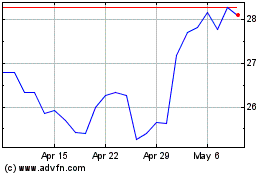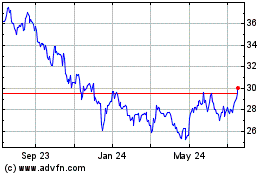By Richard Rubin
WASHINGTON -- The U.S. Treasury Department spent nearly three
years reshaping international corporate transactions, reinforcing
the U.S. tax base and deterring inversions, the controversial
maneuvers that put companies' addresses in low-tax countries.
Now, all that work, capped with a crucial set of final rules in
October, could come undone.
The sudden fragility of the new regulations arises from the
election and the gridlock preceding it. Skeptical Republican
legislators and an incoming administration vowing to repeal
government rules could quickly tear down the regulatory framework
that helped kill large deals planned by Pfizer Inc. and AbbVie
Inc.
President-elect Donald Trump, who has said that he wants to stop
inversions, has suggested that a lower corporate tax rate would
sharply reduce companies' incentives to take a foreign address. Mr.
Trump and Steven Mnuchin, his pick to run the Treasury, have
proposed cutting the corporate tax rate to 15% from 35% as part of
a bigger revamp of the tax code.
As they wrote the rules, Treasury officials used generous
assessments of their own authority, with Congress deadlocked, to
make it much harder for companies to exploit gaps in the U.S. tax
system.
"We have a problem. We asked Congress to address it," said
Robert Stack, Treasury's top international tax official. "They
didn't do anything."
After an April draft prompted fierce lobbying by business groups
and corporations, Treasury's final rules in October pared back the
impact on U.S.-based companies, focusing the impact on
foreign-owned firms.
Those final rules, which could produce $600 million annually in
taxes, capped the Treasury's work. In all, the government erected
new barriers that made it harder for firms to escape the U.S. tax
net and ended some tax-avoidance techniques companies could use
once they had a foreign address.
Still, Republican complaints could prevail if Treasury officials
didn't erode businesses' objections far enough. Congress could
repeal the rules. The Treasury under Mr. Trump can withdraw
them.
"I'm hopeful that he stops those regulations cold," said Rep.
Kevin Brady (R., Texas), chairman of the House Ways and Means
Committee, after the election. "They built a regulation wall to
keep investment out of the United States."
The October regulations themselves drew cautious relief from
businesses. Treasury officials had listened to business feedback,
especially on this year's most expansive rules. Those limit a
tax-avoidance technique called earnings stripping, in which foreign
companies use internal loans to generate interest deductions
against the 35% U.S. tax rate and push income into lower-taxed
jurisdictions. Companies that invert often strip earnings to get
the full benefit of a foreign address.
Inversions had barely registered during President Barack Obama's
first term, but they started getting public attention in 2014 when
Pfizer announced it was considering an inversion, and when
Medtronic Inc. and Mylan Inc. announced their own deals.
Democrats, worried that more firms would flee, proposed targeted
legislation that would make it impossible for companies to invert
by buying a smaller foreign target. Republicans resisted, pushing
for a broader tax-code overhaul.
That left any action to Treasury, and as corporate departures
entered bankers' routine pitches to companies on how to lower tax
bills, the department began to explore its own powers, said Mark
Mazur, assistant secretary for tax policy, who oversaw the rule
making.
That happened in the background while Mr. Obama and Treasury
Secretary Jack Lew prodded Congress. Mr. Mazur, a 60-year-old
longtime government economist, described a bottom-up process,
driven more by Treasury staff.
"At first we thought that we didn't have authority to do much or
anything substantive," he said.
Publicly, that posture flipped quickly, and Mr. Obama urged them
along. Announcements followed in September 2014, November 2015 and
April 2016, produced by a core group of about 12, along with an
Internal Revenue Service team.
The Treasury's team worked outside public view to protect
market-moving information from leaking to investors before
releasing rules that curtailed benefits for foreign-owned
companies. During that whole rule-making period, Treasury's senior
tax officials, virtually unknown outside the tax world, operated
under unusual scrutiny from people invested in cross-border deals.
Mr. Stack recalled seeing the same investors or their
representatives over and over, conspicuous at tax conferences where
everyone knows everyone.
The investors sought mundane scraps of information such as
Treasury Department holiday schedules to unearth details of the
decade's most consequential tax rules. They peppered another
official with questions in a hotel elevator. "They're always
looking for some little hint," Mr. Mazur said.
Treasury's move in April was its most surprising, curbing what
the government called "serial inverters," or companies growing
through multiple inversions. That killed Pfizer's plan to buy
Allergan PLC and take an Irish address. Treasury officials were
aware of transactions but insist they weren't targeting particular
companies.
Simultaneously, Treasury proposed an earnings-stripping rule,
which alarmed U.S.-based companies because it relabeled some
internal debt as equity and imposed steep compliance costs.
Treasury officials met with roughly 50 companies and trade
groups this year. Some CEOs went straight to Mr. Lew, who directed
their tax and finance experts to Mr. Mazur. Eventually, Mr. Mazur's
team joked they would have covered the entire Fortune 100 with just
a few more meetings.
Treasury "proved to be much more flexible and much more
accommodating" than experts expected, said David Golden of Ernst
& Young LLP.
Inversions are "less attractive" now, but the rules still
discourage foreign investment, said Jason Bazar, a partner at Mayer
Brown LLP.
Write to Richard Rubin at richard.rubin@wsj.com
(END) Dow Jones Newswires
December 02, 2016 07:14 ET (12:14 GMT)
Copyright (c) 2016 Dow Jones & Company, Inc.
Pfizer (NYSE:PFE)
Historical Stock Chart
From Mar 2024 to Apr 2024

Pfizer (NYSE:PFE)
Historical Stock Chart
From Apr 2023 to Apr 2024
